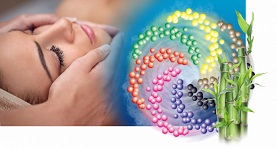Among the wonderful new materials with unexpected properties that will change our world is microcrystalline cellulose. I got a new perspective on it through the lecture of Stéphane Laurent at the Siñal exhibition in Châlons-en-Champagne, end May. Microcrystalline cellulose (MCC) is a relatively recently developed material with many applications.

Production from cellulose
MCC is a polysaccharide consisting of several hundred to over ten thousand glucose units that are β(1→4) linked (for connoisseurs). It is prepared by treating alpha cellulose, obtained as a pulp from fibrous plant material, first with mineral acids and then with hydrochloric acid. Natural cellulose has both amorphous and crystalline regions, and the acids attack the amorphous regions, leaving the crystalline regions for further purification. MCC is a tasteless, odourless crystalline powder; it is hygroscopic in nature and insoluble in water, but with water it swells and produces a gel. One of the companies that markets MCC is J. Rettenmaier & Söhne GmbH (JRS), a German family-owned company operating worldwide, the employer of Stéphane Laurent.
Microcrystalline cellulose is available in different sizes (25-250 µm) that have different properties. It is non-toxic, consisting of 99+% dietary fibre and some salts, and it is biodegradable. One of its main applications is in pharmacy, where it is the most widely used tableting agent. Because of its properties, among which chemical purity and high crystallinity, many more applications start to develop like in sprays, oral suspensions and lotions. Here, it is an alternative to synthetic gels or polymers.

Microcrystalline cellulose in food products
A second major area of applications is in food & beverages. Here MCC is used as an anticaking and bulking agent, properties that are lent to it by its insolubility in water. Applications depend much on particle size. The smallest particles (20 µm) are used in instant sauces, soups and drinks. Larger particles are used as anticaking agent and free-flowing agent. Here, it is alternative to silica or TiO2. MCC also acts as a fat alternative, e.g. in light mayonnaise. It lends texture to the product, stabilizes the mixture of components, and at the same time does not have any calorific value. Other products where it lends comparable services are whipped cream, mousse au chocolat, ketchup and ice cream. As a gel, it has applications like stabilizer and thickener. MCC has been approved in the EU as a thickener, stabilizer or emulsifier under the E-number E460(i), where cellulose itself has been given the number E460.
A third large application area is in cosmetics. In baby powder, microcrystalline cellulose is an alternative to talc. It combines high absorption capacity with low bulk density and it has an excellent skin feel. Therefore it is much applied in products like shampoos, masks, emulsions and gels. Here, it is an alternative to synthetic gels or polymers. And then, there are applications in detergents (dishwashing tablets) and coatings (barrier effect). When applied on textiles, MCC improves thickness and water vapour permeability. In varnishes, it is an alternative to synthetic binders and improves scratch resistance. Microcrystalline cellulose is a very versatile compound that will find many more applications in the years to come.
Author
Diederik van der Hoeven
Source
Supplier
J. Rettenmaier & Söhne GmbH & Co.
Share
Renewable Carbon News – Daily Newsletter
Subscribe to our daily email newsletter – the world's leading newsletter on renewable materials and chemicals









